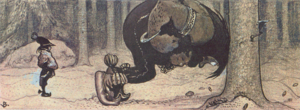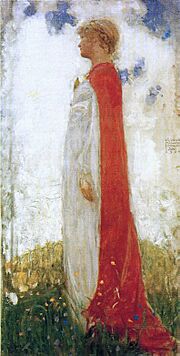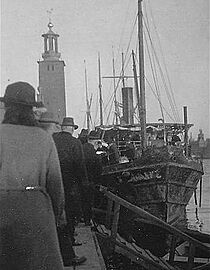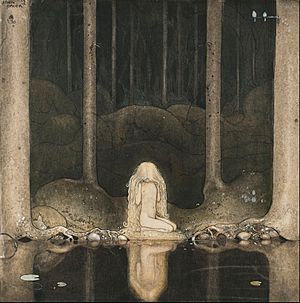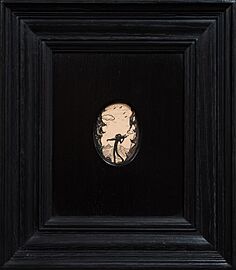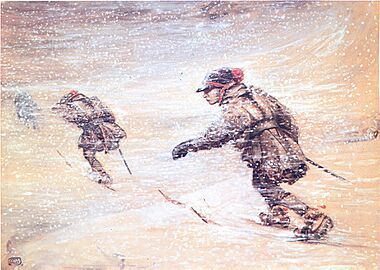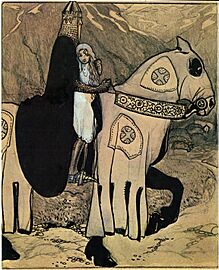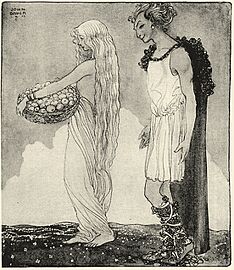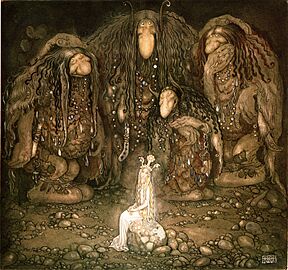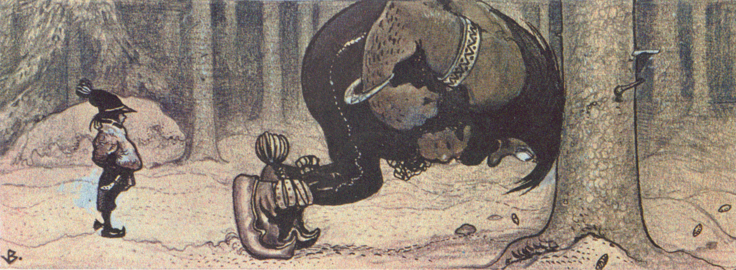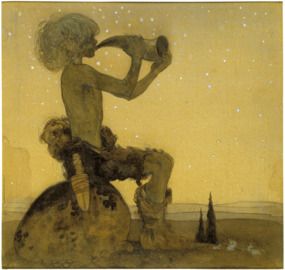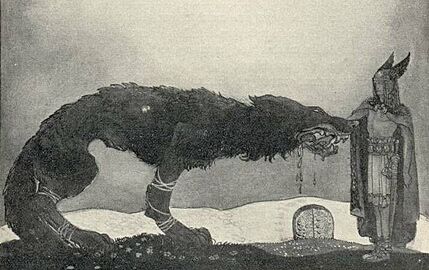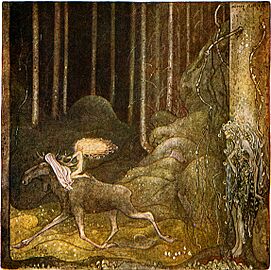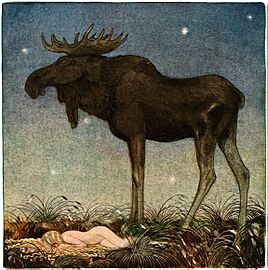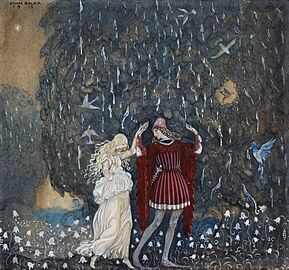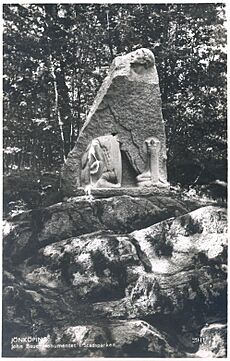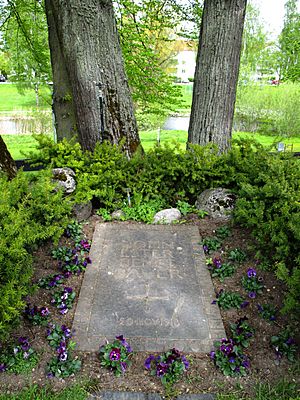John Bauer (illustrator) facts for kids
Quick facts for kids
John Bauer
|
|
|---|---|

John Bauer with his signature
|
|
| Born |
John Albert Bauer
4 June 1882 Jönköping, Sweden
|
| Died | 20 November 1918 (aged 36) Vättern, Sweden
|
| Resting place | Jönköping, Sweden |
| Nationality | Swedish |
| Education | Royal Swedish Academy of Arts, Stockholm |
| Known for | Illustration, painting |
|
Notable work
|
Tuvstarr gazes into the water The Fairy Princess Saint Martin, the Holy |
| Movement | Romantic nationalism |
| Spouse(s) | Ester Ellqvist |
John Bauer (born June 4, 1882 – died November 20, 1918) was a famous Swedish painter and illustrator. He is most known for his magical pictures of gnomes, trolls, and fairy tale creatures. These illustrations brought Swedish folklore and nature to life for many people.
John Bauer's art often showed beautiful landscapes and old myths. He also painted portraits of people. His most famous works are the illustrations for the book series Bland tomtar och troll. This book collected Swedish fairy tales and folk stories.
Bauer grew up in Jönköping, Sweden. When he was 16, he moved to Stockholm to study art. There, he started getting jobs illustrating books and magazines. He also met his future wife, artist Ester Ellqvist. They married in 1906.
Early in his career, John traveled to Lappland, Germany, and Italy. These trips greatly influenced his art. He painted in a style called romantic nationalism. This style combines national pride with a love for nature and old stories. His art was also inspired by the Italian Renaissance and the culture of the Sami people.
Most of his art was done using watercolors. He often used soft, muted colors. He also created oil paintings and frescos (wall paintings). John Bauer's art helped people understand and love Swedish folklore, fairy tales, and the beauty of its landscapes.
Sadly, when John Bauer was 36, he drowned. This happened in a shipwreck on Vättern, a large lake in southern Sweden. His wife, Ester, and their young son, Bengt, also died in the accident.
Contents
John Bauer's Life and Art
Early Years and Art School
John Bauer was born on June 4, 1882, in Jönköping. His father, Josef, came from Bavaria, Germany. His mother, Emma, was from a farming family in Sweden. John's father started a successful meat business in Jönköping.
The Bauer family lived in a house called Villa Sjövik, by Lake Rocksjön. John had two brothers, but his only sister died young. Their family home was always important to him.
From a young age, John loved to draw. He would often sketch funny pictures of his teachers. He spent a lot of time daydreaming, which his teachers didn't always like.
When he was 16, John wanted to study art in Stockholm. His family was very supportive and helped him financially. In 1898, he applied to the Royal Swedish Academy of Arts. He was very talented, but too young to be accepted. So, he spent two years at another art school.
In 1900, John was old enough to join the Academy of Arts. He was one of only three students accepted that year. He learned about traditional illustration, drawing plants, and old costumes. These skills were very useful in his later work. One of his teachers, Gustaf Cederström, praised John's art. He said John's small works felt more powerful than many huge paintings.
While at the academy, John started getting jobs illustrating magazines and books. In 1904, he traveled to Lappland to draw pictures for a book about the area. By the end of 1905, he finished his studies and proudly called himself an "Artist."
Journey to Lappland
In the early 1900s, people became very interested in Lappland, in northern Sweden. It was seen as a place of both wild nature and new industry. A publisher named Carl Adam Victor Lundholm wanted to create a book about Lappland. He hired famous Swedish artists to draw pictures for it.
John Bauer was not as experienced as the other artists. So, Lundholm asked him to draw some Sami people at Skansen (an open-air museum) to test his skills. John wasn't thrilled about this test.
On July 15, 1904, John went to Lappland for a month. He was amazed by the wide-open spaces and colorful landscapes. He came from the dark, dense forests of Småland, so Lappland was very different. His time with the Sami people and their culture became very important for his art.
He took many photos, sketched, and wrote notes about Sami tools, clothes, and objects. He found it hard to get close to the shy Sami people. He wrote about his experiences in his diary and in letters to his family.
The Lappland book was published in 1908. It included eleven watercolors by John Bauer. He painted these in Stockholm, using the photos and sketches from his trip. Many of his photos also led to other drawings and paintings. He captured the feeling of the Sami homes (goahtis) and the rich details of their clothing. Details from Sami culture, like bent knives and special shoes, often appeared in his later troll illustrations.
Love and Family Life
John met Ester Ellqvist at the Royal Swedish Academy of Arts. She was also an artist, but women had to study in separate classes back then.
John started writing to Ester in 1903. They shared their dreams and feelings in their letters. For John, Ester became his inspiration and his "fairy princess." He painted her for the first time in Sagoprinsessan (The Fairy Princess). He made sketches in 1904 and finished the oil painting in 1905. In the painting, Ester looks strong and almost like a Valkyrie (a warrior maiden from Norse myths). This painting is now in the Jönköpings läns museum.
John wanted Ester to be his perfect artist's wife. He dreamed of them living in a romantic cottage in the woods. He wanted to wander the forest for inspiration while she made a home.
Ester, however, grew up in Stockholm and loved city life. She wanted a comfortable home, a husband, and children. John was not yet a successful artist. He often relied on his parents for money. He proposed to Ester without his parents' approval, as they thought he should be more settled first.
John and Ester married on December 18, 1906. They lived together, so they didn't need to write letters anymore. John got jobs illustrating magazine covers and started working on Bland tomtar och troll.
In 1908, John and Ester traveled to Italy. When they returned, they found a house called "Villa Björkudden" near Lake Bunn. They bought it in 1914. The next year, their son Bengt was born. They called him "Putte." Putte's birth brought a lot of happiness to the couple.
John made his last illustrations for Among Gnomes and Trolls around this time. He wanted to try new things like writing plays and painting frescos. He also showed his paintings in exhibitions and explored modernism.
John started painting pictures with children after his son was born. His painting Rottrollen (The Root Trolls), from 1917, shows Putte sleeping among tree roots that look like trolls.
Journey to Italy
In 1909, John and Ester took a long trip to Italy. John's father paid for the journey. They traveled through Germany and visited cities like Verona, Florence, and Siena. They spent two months in Volterra and then continued to Naples and Capri. They spent the winter in Rome.
During their travels, they studied art and visited many churches and museums. John loved learning about different art styles. In the evenings, they went to small restaurants to enjoy the local atmosphere. John wrote about all these experiences in letters to his family.
John's sketchbooks are full of drawings of old objects and Renaissance art. He used some of these ideas in his illustrations. For example, a portrait by Sandro Botticelli might have inspired his painting Svanhamnen (The Swan Maiden). The work of Piero della Francesca inspired Den helige Martin (Saint Martin, the Holy). John also became very interested in frescos.
Even though he loved studying art, John missed the quiet forests of Sweden. This feeling led him to paint some of his best winter scenes, with white snow, dark woods, and sparkling stars.
Their trip ended early because of a misunderstanding with the police in Rome. This left a bad memory of their visit.
The Tragic End on Lake Vättern
John, Ester, and their three-year-old son, Bengt, were moving to a new home in Stockholm. John hoped for a fresh start for his family and his art. There had recently been a bad train accident nearby. Because of this, John decided they should travel by boat, the steamer Per Brahe.
On the night of November 19, 1918, the steamer left Gränna. It was heavily loaded with iron stoves, farm tools, sewing machines, and barrels. Much of the cargo was left unsecured on the deck, making the ship very top-heavy.
The weather was terrible. A strong storm was raging on the lake. The wind caused the cargo on deck to shift and fall overboard. This made the ship even more unstable. The ship then flipped over and sank, stern first. It went down only about 500 meters (1,640 feet) from the next port, Hästholmen. All 24 people on board died, including John, Ester, and Bengt Bauer. Most passengers were trapped in their cabins.
The wreckage was found on November 22, 1918, at a depth of 32 meters (105 feet). The ship was brought up from the lake on August 12, 1922. Investigations showed that only one-third of the cargo had been stored properly in the hold. The rest was unsecured on deck.
The salvage operation became a strange public event. Thousands of people came to watch the ship being raised. Newsreels about it were shown in cinemas across Sweden. Some newspapers even suggested that mythical forest creatures had sunk the ship to claim Bauer. This idea was linked to the tale Agneta och sjökungen (Agneta and the Sea King), which Bauer had illustrated. In this story, a Sea King lures a maiden into the water.
On August 18, 1922, the Bauers were buried in the Östra cemetery in Jönköping.
John Bauer's Art and Style
Favorite Subjects
John Bauer loved Swedish nature, especially the deep forests. He imagined all sorts of creatures living there. His paintings often show detailed plants, moss, and mushrooms found in Swedish woods. He is most famous for his illustrations in Among Gnomes and Trolls.
A friend of his, Ove Eklund, said that John believed the creatures he drew were real. Eklund often walked with John in the forests by Lake Vättern. John's descriptions made Eklund feel like he could see the creatures too.
Artistic Influences
John Bauer was part of a new group of Swedish painters. They started their careers just before Modernism became popular. John was inspired by famous Swedish artists like Carl Larsson and Anders Zorn. He also learned from German illustrators like Fritz Erler.
He lived at a time when old Norse myths were very popular in Scandinavia. He took ideas from artists like Theodor Kittelsen and Erik Werenskiold. But his final artworks always had his own unique style. After his trip to Italy, his art clearly showed ideas from the 14th-century Renaissance. His princes and princesses looked like figures from Flemish tapestries. Even his trolls' clothes looked like the draped clothing in old Roman sculptures.
How John Bauer Painted
John Bauer had a very detailed way of painting. He would start with a tiny sketch, like the size of a stamp, showing just the basic shapes. Then he would make a slightly bigger sketch with more details. He would keep making bigger and more detailed sketches until the artwork reached its final size. Most of his original pictures for About Gnomes and Trolls were square, about 20 to 25 centimeters (8 to 10 inches) in size.
He would draw on anything he could find, even old paper or the back of an envelope. Many of his sketches look like comic strips, where the pictures get bigger and more detailed. He would also create different versions of the same picture, for example, one in summer and one in winter. He didn't follow the strict rules about art materials at the time. He could make a complete artwork using just pencil or charcoal, or a sketch in oil.
Early in his career, John had to adapt his art to the printing technology of the time. Printing in full color was expensive. So, his early illustrations were often made in one color plus black. As printing improved and his art became more popular, his pictures were eventually printed in full color.
Watercolor Art
John Bauer's most famous pictures are his watercolors. He used this technique for illustrating books and magazines. He often mixed aquarelle and gouache. Aquarelle is a transparent watercolor, while gouache is opaque (you can't see through it). He used both because he needed the speed of aquarelle and the strong contrast of gouache. These water-based paints dried quickly, which allowed John to work on his pictures until the very last minute before his deadlines.
Among Gnomes and Trolls
In 1907, a publishing house asked John Bauer to illustrate their new book series, Among Gnomes and Trolls. These books would come out every year and feature stories by famous Swedish writers.
Most of John's pictures for the book were full-page watercolor illustrations. He used soft, muted colors. He also designed the covers and smaller drawings. His most important creatures, the trolls, were often painted in shades of gray, green, and brown. These were the colors of the forest, making it seem like the trolls grew right out of the landscape.
Because of printing limits, the books from 1907–1910 were printed in only two colors: black and yellow. Some of John's original paintings for these books were actually in full color.
In 1911, when he was asked to illustrate the book again, John wanted to keep his original pictures and the rights to them. The publisher had kept the originals from earlier editions. John was supported by other artists who faced the same problem. The publishers didn't agree at first, and without John's illustrations, book sales dropped.
The publisher finally agreed for the 1912 edition. John was back to illustrating his own book. Printing technology had also improved. Pictures could now be printed in three colors: black, yellow, and blue. This made the prints look much more like John's original paintings.
John illustrated the books from 1913–1915. The year 1913 was a high point for his work in these books. His illustrations from that edition are still some of his most famous. In 1914, his pictures started to show influences from the Italian Renaissance.
By this time, John wanted to stop illustrating the series. But he had a contract to do one more book. So, 1915 was his last year working with trolls and gnomes. He said he was "done with them" and wanted to try new things. The war in Europe had changed his view of the world, and he felt he could no longer imagine it as a fairy tale.
The Princess and the Moose
Ännu sitter Tuvstarr kvar och ser ner i vattnet (Still, Tuvstarr sits and gazes down into the water), painted in 1913, is one of John Bauer's most famous works.
For many years, the most popular of John Bauer's works were two paintings from the story Sagan om älgtjuren Skutt och lilla prinsessan Tuvstarr (The Tale of the Moose Hop and the Little Princess Cotton Grass), published in 1913. One picture shows the princess riding on the moose, and the other shows the moose guarding the sleeping princess. These were often used as pictures in children's rooms.
The same story also includes the painting of Princess Tuvstarr looking into a forest pond for her lost heart. This picture is often seen as a symbol of losing innocence. John made several studies of this scene.
In the 1980s, the painting of Tuvstarr and the pond was used in shampoo advertisements. This led to a debate in Sweden about how national art should be used. In 1999, the picture appeared in advertising again. This time, the trees in the picture were cut down, and Tuvstarr looked sad. This award-winning ad campaign was made by the Swedish Society for Nature Conservation. It helped to raise awareness for the environmental movement in Sweden.
Larger Artworks
John Bauer was always interested in large wall paintings, or frescos. This interest grew even more after his trip to Italy. His first chance to create a big fresco was in 1912. He made a 1.5 by 1.5 meter (5 by 5 foot) fresco-secco mural called Vill-Vallareman for a publisher's home.
In 1913, he was asked to create a fresco for the Odd Fellows lodge in Nyköping. This painting was called Den helige Martin (Saint Martin, the Holy). At the same time, the new Stockholm Court House was being built. Many famous Swedish artists entered contests to decorate the building. John Bauer made several sketches for these contests, but he lost confidence and didn't submit any of his designs.
John Bauer's last large work was an oil painting for the auditorium at the Karlskrona flickläroverk (The Karlskrona School for Girls) in 1917. It shows Freja, the old Norse goddess of love, war, and magic. Ester, John's wife, posed for this painting. John showed her as strong and powerful.
Exhibitions
Some of the exhibitions of his work during his lifetime were:
- 1905 Gothenburg
- 1906 Norrkoping
- 1911 Rome
- 1913 Munich
- 1913 Dresden
- 1913 Brighton
- 1913 Stockholm
- 1914 Malmö
- 1915 San Francisco – Bauer was awarded the medal of honor.
After his death, his works were shown in many exhibitions, including:
- 1934–45 Traveling exhibition
- 1968 Jönköpings läns museum, Jönköping
- 1973 Thielska galleriet, Stockholm
- 1981–82 Nationalmuseum, Stockholm
- 1993 Milesgården, Stockholm
- 1994 Göteborgs konstmuseum, Gothenburg
Collections
The Jönköpings läns museum has over 1,000 paintings, drawings, and sketches by John Bauer. This is the largest collection of his art in the world. His work is also found in the Nationalmuseum in Stockholm, the Gothenburg Museum of Art, and the Malmö konstmuseum. The John Bauer Museum in Ebenhausen, Germany, is dedicated to his life and art.
Works
For illustrations from the famous children's anthology, see Among Gnomes and Trolls
Other works
Written work
John Bauer's Thoughts on His Art
John Bauer often had doubts about his own work. He felt that the praise he got for his trolls and princesses was just "a nice pat on the head for making funny pictures for children." He really wanted to paint in oil and create what he called "real art." But he needed the money he earned from his illustrations. His self-doubt was different from how he appeared in public and in his self-portraits, where he looked strong-minded.
John Bauer's Legacy
John Bauer's pictures are still very popular today. His artworks often sell for high prices at art auctions. For example, in 2014, one of his gouache paintings sold for about US$87,000.
His illustrations have been printed many times and are considered classic fairy tale art. As of 2014, books with John Bauer's pictures have been published in ten different languages. His works have inspired many other illustrators around the world.
In Jönköping, there is a monument honoring John Bauer in the Town Park. It was created in 1931 by Swedish sculptor Carl Hultström. Hultström also made a bronze bust (a sculpture of the head and shoulders) of John Bauer. This bust is in the National Portrait Gallery at Gripsholm Castle.
To celebrate John Bauer's 100th birthday in 1982, the Swedish postal service released three stamps with pictures from Among Gnomes and Trolls. Four more stamps were issued in 1997. A park and a street in Jönköping are named after him, near where his family home, Villa Sjövik, once stood. There is also a street named after Bauer in Mullsjö and a square in Nyköping.



